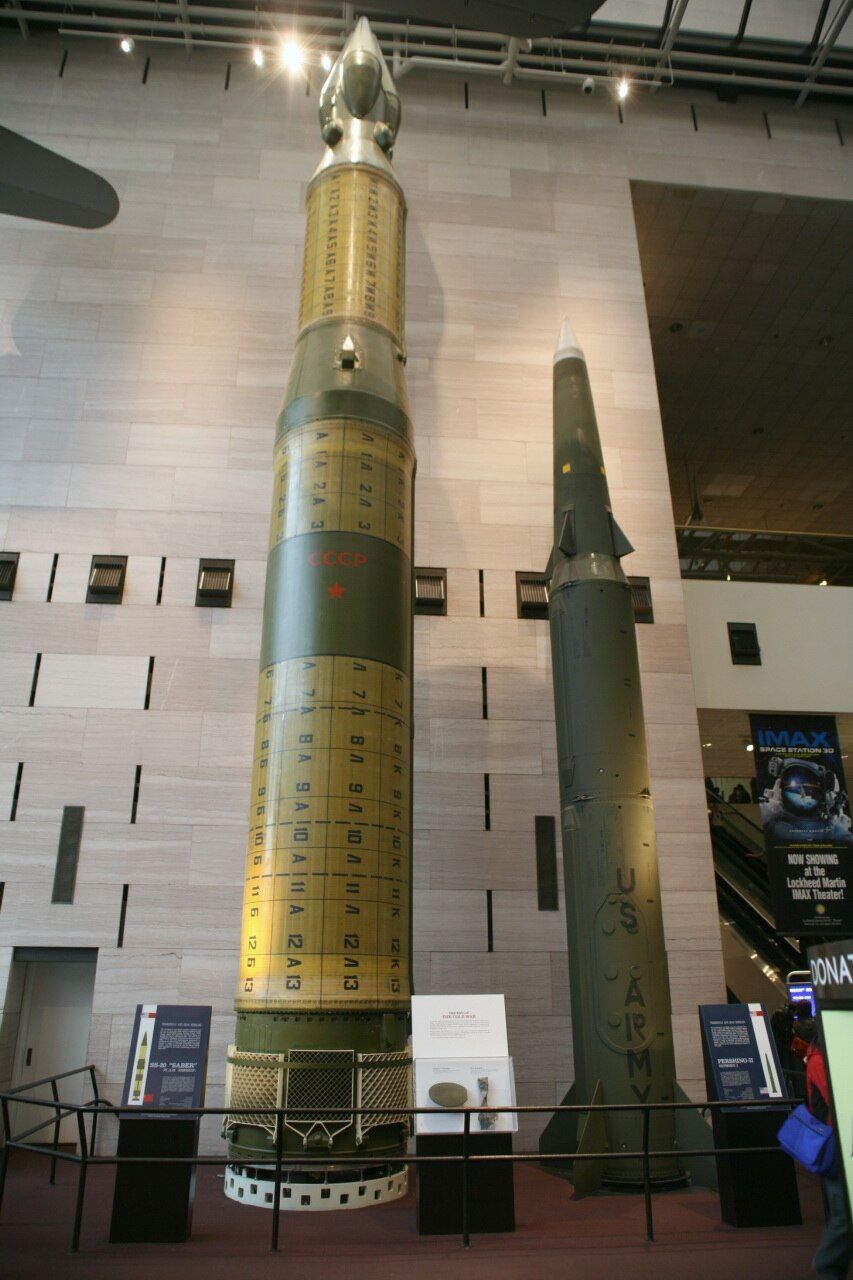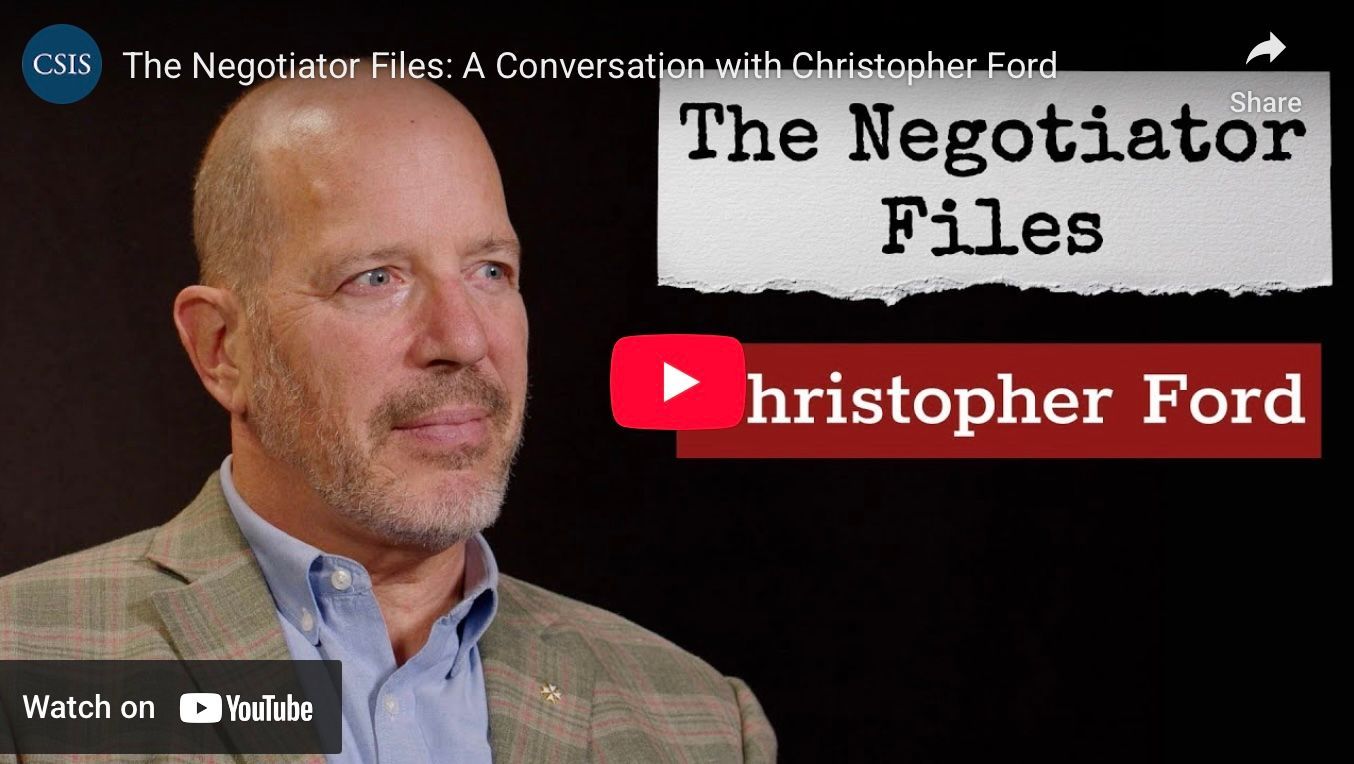Arms Control in Outer Space: History and Prospects
Below is the text of the twelfth paper in the ACIS Papers series produced by the Office of the Under Secretary of State for Arms Control and International Security. This paper may also be found in PDF form on the bottom of this page.
Arms Control in Outer Space: History and Prospects
by
Dr. Christopher A. Ford
Arms Control and International Security Paper Series
Volume I, Number 12
July 24, 2020
In this ACIS Paper , Assistant Secretary Ford discusses longstanding efforts to find effective forms of arms control in outer space and the reasons such efforts have failed in the modern era, before exploring what prospects there yet may be for international efforts to reduce risk, increase transparency and predictability, and head off the dangers of an outer space arms race — even as both the Russian Federation and the People’s Republic of China (PRC) are rushing to weaponize the space domain.
Diplomats have been struggling with what to do about security issues in outer space for many years. To be sure, in 1959 , the United Nations General Assembly established a Committee on Peaceful Uses of Outer Space (COPUOS), and in 1963 , it adopted a series of legal principles to govern the exploration and use of outer space. The Outer Space Treaty , furthermore, entered into force in 1967, setting forth important rules such as that outer space shall be free for exploration and use by all, that it is not subject to national appropriation by claim of sovereignty, that States Party may not station weapons of mass destruction (WMD) in space, and that States shall use the Moon or other celestial bodies exclusively for peaceful purposes.
Yet despite the Treaty’s significance in setting a global baseline for space conduct, the Outer Space Treaty had little to say about the risks and challenges that would be presented as States extended their terrestrial rivalries and arms competitions into the space domain in ways that didn’t involve WMD. Similarly, the Partial Test Ban Treaty imposed a prohibition upon nuclear explosions in space in 1963 , but very little of what might be termed “arms control” was developed to address non-WMD challenges. (Nor has that Treaty been signed by China.)
History records one major attempt by the United States in the late 1970s to negotiate an agreement on anti-satellite (ASAT) weapons. In November 1977, President Jimmy Carter wrote Soviet General Secretary Leonid Brezhnev that Soviet anti-satellite (ASAT) testing in space had become “ of increasing concern to us.” Carter warned that a Soviet co-orbital ASAT was “a seriously destabilizing development which we have voluntarily foregone, although we have the technical capability to build [such] systems.” However, bilateral negotiations in 1978 and 1979 with the USSR on ASAT arms control were hampered not only by technical definitions of anti-satellite capabilities, but also Moscow’s insistence that the U.S. space shuttle program be subject to any ASAT agreement.
In a foreshadowing of present-day Russian hypocrisies, history also records that the Soviet Union was developing its own space shuttle in a secret program even while it was negotiating to impose restrictions on the U.S. space shuttle. Although that Soviet program was abandoned after conducting one flight test in 1988, it is not clear that Moscow’s approach to such issues has changed much.
In the four decades since U.S.-Soviet ASAT talks broke down, the use of space and the dependence of terrestrial society upon space-facilitated communication and other innovations has expanded. The problems of intensifying great power competition have also increased, after a brief post-Cold War lull, and threats to the free exploration and use of outer space have become ever more acute. Today, we are all vastly more dependent upon space than ever, even as threats to space activities are maturing at an alarming rate.
As a result of such problems, diplomats at the U.N. Conference on Disarmament, for instance, have been talking – albeit often more at each other than with each other – about “prevention of an arms race in outer space” since the early 1980s, with little to show for their efforts so far. For present-day diplomats struggling with these issues and seeking a genuinely constructive path forward, it is important to understand why so many of those past efforts have proven to be a dead end, for without such understanding it will be needlessly difficult to take advantage of the real opportunities for progress that nonetheless remain.
I. Failures of "Arms Control in Space"
To date, efforts to apply traditional, rule-prohibitive “arms control” measures in outer space have repeatedly run aground because the outer space domain is simply, by its nature, inappropriate for such mechanisms. This isn’t anyone’s fault , exactly – though the modern authoritarian powers of the Russian Federation and the People’s Republic of China (PRC) have tried to take advantage of those who don’t understand the problem, in both cases discreditably – but it is a reality that present-day diplomats need to accept and learn to work with.
A. Insoluble Problems
The fundamental difficulty, if one is trying to limit or ban “weapons in space” in the way that traditional arms control tries to address other dangerous tools, is that it is all but impossible to come up with a good definition of a “ space weapon.” Try as one might, there seems to be no way to avoid being damagingly over -inclusive ( i.e., leading to the prohibition of technologies essential to peaceful civilian and scientific uses of space), dangerously under -inclusive ( i.e., failing to cover entire categories of anti-space weaponry), or both.
As I have been warning for more than a decade , this difficulty stems in large part from the dual-use nature of space technology, since essentially anything that can maneuver in space at all can function quite effectively as a “space weapon.” Even the merest “fender bender” between delicate technological objects moving at orbital velocities is enough to cause debilitating (or catastrophic)damage, and if an object has the ability to move through space, let alone actively to maneuver in that domain, it has the inherent potential to smash an adversary space object into smithereens. Nor does a “weapon” even have to make physical contact, since even radio transmitters or other energy emitters can function as counterspace weapons by jamming or manipulating control signals, or damaging sensors or other equipment in ways which can disable or destroy space objects.
These definitional challenges are only worsening, with the advent of sophisticated new technologies for on-orbit satellite maintenance and repair. After all, the same sorts of capabilities that might allow one satellite to do things such as replace a depleted fuel reservoir on another satellite could just as easily be used to damage an object, or perhaps even capture it for subsequent exploitation. (One might perhaps analogize this problem to that of the human hand itself, which with its dexterous digits and opposable thumb is marvelously good at using tools for human betterment, yet also quite good at scratching and poking, and makes a very effective fist. How would one define and prohibit possession of a “hand weapon,” or its “deployment” at the end of a human arm?) This problem has been recognized for years, including by a group of governmental experts commissioned by the U.N. Secretary General, who reported in 1993 that
The dual-use character of so much space-related technology thus makes “space weapons” very resistant to the kind of straightforwardly prohibitive treatment that comes as a reflex to large parts of the arms control community. Even the Obama Administration, for example, which came to office pledging to pursue “ a worldwide ban on weapons that interfere with military and commercial satellites ,” subsequently realized that such a “ban” approach was a fool’s errand.
Moreover, even if one could define the problem, no intelligible scheme for verifying such a prohibition has ever been devised, as Russia and China, the primary drafters of such misbegotten initiatives as the “Treaty on the Prevention of the Placement of Weapons in Outer Space, the Threat of Use of Force against Outer Space Objects” (PPWT), have themselves admitted at the Conference on Disarmament. Systematic international close-in inspection of devices in orbit – presumably aimed at discerning weapon-like capabilities, to the extent that these could somehow be distinguished from other capabilities – seems quite unfeasible even for the thousands of space objects that currently orbit the globe, let alone for the many thousands more that are being readied in this effervescent era of rapidly-advancing space innovations. (Such close inspections might also increase operational risk if not conducted by the most skilled of operators, for it is very difficult to do such operations, and undertaking them – especially without notice – could increase misunderstandings regarding a country’s intentions. Recent Russian close-proximity maneuvers, for instance, may have resulted in a collision creating potentially dangerous space debris.)
Nor has any serious verification regime ever been proposed for terrestrially-based anti-satellite (ASAT) weaponry, which can take greatly varying forms – including direct-ascent missiles that are not morphologically different from other sorts of long-range missiles that transit space altitudes, as well as directed-energy or radio-frequency emitters largely indistinguishable from those that sophisticated modern militaries might possess for a range of evolving terrestrial applications. For the elementary reasons of velocity and physical fragility described above, every country on the planet with a space launch capability, moreover, has a degree of inherent space kill capability. How could one possibly verify “non-weaponization” across this domain? Even setting aside its apparently insoluble definitional conundra, therefore, effective and verifiable “arms control in space” currently seems entirely unavailable.
B. Disingenuous Proposals
Serious observers of the space domain recognize these problems, but this has not stopped some countries – most prominently Russia and the PRC – from trying to take advantage of others’ ignorance, credulity, or wishful thinking in order to advance disingenuous and potentially even dangerous “arms control” proposals. Exhuming a treaty proposal first advanced by Soviet President Yuri Andropov in 1983 , Moscow and Beijing first began efforts to promote the idea of a treaty on “prevention of an arms race in outer space” (PAROS) as early as 2002, and by 2008 they had begun touting a full-fledged draft treaty text. A revision of this treaty was proffered in 2014, the current version styling itself the PPWT.
Russia and the PRC even managed to persuade enough countries to support the idea that the U.N. General Assembly established a group of governmental experts (GGE) in 2017 to explore the parameters of a legally-binding instrument on preventing an arms race in space, including a prohibition of the placement of weapons in space. Resolutions along such lines also commonly pop up in the U.N. First Committee. (Interestingly, and perhaps tellingly, although Russia touts its unilateral commitment not to be the “first” to place weapons in space – about the special absurdity of which I will have more to say below – Moscow’s ally in these space arms control efforts, the PRC, has refused to make such a commitment.)
None of these efforts, however, do anything meaningful to solve the problems described above, which are intrinsic to any attempt to apply traditional weapon-prohibitory “arms control” in the space domain. They neither provide a workable definition of a “space weapon” nor do they even attempt to provide a way to verify their purported prohibition thereof.
By no coincidence, furthermore, none of these efforts even attempt to address the problem of terrestrially-based ASAT capabilities that – as this paper will describe further below – both Moscow and Beijing today possess. Proponents of the draft PPWT claim that it would ban the threat or use of force against space objects of other parties and the placement of weapons in space itself, but nothing in the draft treaty would prevent Russia and the PRC from continuing to build up their already worrisome arsenals of counterspace weaponry deployed here on Earth. In effect, the Sino-Russian “space arms control” campaign thus amounts to little more than an effort to prohibit the sort of space-based conventional weapons they fear the United States might deploy at some point in the future, while still allowing Moscow and Beijing to continue with their own terrestrially-based anti-satellite missiles, lasers, jammers, and other such devices.
The PPWT’s defects are thus simultaneously structural , insoluble , and apparently intentional. That draft treaty is therefore not “arms control” worthy of the name, and the world deserves better. Nor, for all of these reasons, are its defects ones that can effectively be addressed within the terms of reference this disingenuous gamesmanship sets for itself. If we are to have some kind of negotiated and agreed approaches to reducing risk and managing competitive tensions in the space domain, therefore, we will need to look elsewhere.
C. Rapidly-Evolving Space Threats
Making matters worse, and the hypocrisy of the PPWT all the more impressive, both Russia and China are presently leading the world in weaponizing the space domain – including, in Russia’s case, even through the actual placement in outer space of satellites that fire projectiles: that is, things that appear to be weapons. As I summarized things in remarks at CSIS in April:
And, if anything, Russia’s behavior has been even worse.
Despite his diplomats’ ostentatious enthusiasm for efforts such as PPWT, Putin has declared space weapons to be “acceptable in the political and military respect,” and in April 2020, Russia carried out a flight test of its direct-ascent ASAT missile. On July 3, furthermore, Colonel General Sergei Surovikin, the commander of Russia’s Aerospace Forces, admitted that their S-500 “Prometey” missile defense systems can serve as a ground-launched ASAT. He told the Russian Defense Ministry’s Krasnaya Zvezda newspaper that “[t]he S-500 can be classified as the first generation of space defense systems, since in the future it will be able to destroy low-orbit satellites and space weapons.”
Most amazing, however, is that Russia seems already to have placed weapons in space – a step which, would be a clear violation of the draft treaty Moscow has itself been promoting, [1] not to mention outrageously at odds with Russia’s own efforts to promote a U.N. resolution on “No First Placement of Arms in Outer Space.” As I have outlined it elsewhere, but which essentially anyone can verify by checking orbital tracks available on Space-Track.org,
The country that claims to want to ban the placement of weapons in space therefore seems already to have placed weapons there – and now to be using dangerous maneuvers in orbit, by satellites that have demonstrated their ability to fire projectiles at other satellites, as a tool of threat and intimidation. A humorist might point out that this creates a golden opportunity for the Kremlin’s “no first placement of arms in outer space” diplomacy, since now that Russia has itself become the first to do so, there’s no reason the rest of the world couldn’t sign up to that pledge with complete equanimity even while moving ahead with their own space weaponry. We should demand more from space diplomacy, however, than sour punch lines.
The disingenuous effrontery of Moscow’s “space arms control” propaganda is thus today on full display, and now that Russia has itself broken whatever 40-year-old taboo there may have been upon placing weapons in orbit, the stage now seems set for a dangerous new arms race in an arena troublingly unsuited to traditional arms control. As it stands, no one who fails to condemn Russia’s actions in space can claim to be at all serious about preventing an orbital arms race.
II. Transparency and Confidence, and Space Norms
But what can be done to reduce threats to space access and risks to stability in this domain? As it turns out, if one is willing to put aside unworkable weapon-prohibitory dreams – and of course with the caveat that negotiated arrangements are not to be valuedfor their own sake but rather on the basis of how they contribute to security and stability goals – one might be able to do quite a bit.
Experts have been debating possibilities for transparency and confidence-building measures (TCBMs) in outer space for many years. Such diplomatic discussions go back at least to 1990, and in 1993 a group of governmental experts (GGE) sponsored by the U.N. Secretary General produced an extensive report on the topic. They concluded that TCBMs were possible in the space domain, and that they could helpfully complement other efforts to create and maintain confidence between States:
More recently, a U.N. General Assembly resolution in 2010 established another GGE to look at such issues, which submitted its own report, adopted by consensus in July 2013. Among other things, it recommended that countries do more to publicize and share information on their national space policies, on developmental and operational space systems, on each country’s principles and goals in the space arena, and on what objects they had placed in space and their general function. It also called for the improvement of norms of behavior related to space flight safety and risk reduction, suggested that countries should notify others of in-flight maneuvers that could result in risk to others, and generally urged “[t]imely and routine consultations through bilateral and multilateral diplomatic exchanges and other government-to-government mechanisms, including bilateral, military-to-military, scientific[,] and other channels.”
This is sensible advice, and indeed many such things are already done, at least by responsible spacefaring powers such as the United States. Pre-launch notifications of ballistic missiles and space launch vehicles occur routinely among subscribing States under the Hague Code of Conduct Against Ballistic Missile Proliferation (HCOC), for example. Also, there is an increasing amount of global data-sharing about space situational awareness, hazard notifications are common practice, and many countries have publicized their space policies. A United Nations register of space objects has also been kept for many years, pursuant to the 1974 Registration Convention, and extensive international cooperation has developed for orbital debris mitigation and spaceflight safety information exchanges, including through the Inter-Agency Space Debris Coordination Committee , the Consultative Committee for Space Data Systems , and the United Nations’ COPUOS. There is also constructive thinking underway in both government and the private sector about how to improve commonly-understood best practices in areas such as satellite collision avoidance, cooperative on-orbit rendezvous and servicing operations, and utilization of space resources.
Nevertheless, there is more that could be done, particularly with regard to TCBMs and practices and understandings specificallyrelated to the security challenges that countries increasingly face in the space domain. With so many diplomats having been preoccupied by disingenuous distractions such as the PPWT, too little progress has been made in closing the gap between what could be done in the development of security-related space norms and TCBMs and what has been done, even while Russian and PRC weaponization in the space domain has proceeded apace. We must do better, both globally and between the world’s major potential space adversaries.
In this respect, it is worth remembering that outside or on the margins of the space arena, there is a long history of efforts between great power competitors to develop understandings of appropriate behavior and to build practices that support predictability and stability, reducing the chances of misunderstanding and inadvertent escalation. Some of these practices, or things inspired by them, might be useful in helping mitigate space security risks, suggesting that this history could perhaps today be “mined” for potential analogous application in the space domain.
Some prior approaches even resulted in express agreements, such as the Agreement on Measures to Reduce the Risk of Outbreak of Nuclear War signed between the United States and the USSR in 1971. Under that agreement, each Party undertook, among other things, to notify the other in the event of “detection by missile warning systems of unidentified objects, or in the event of signs of interferences with these systems or with related communications facilities” that might create a risk of outbreak of a nuclear war. They also agreed to give advance notice of planned missile launches in the case that any such launches extend beyond the national territory of the launching Party and in the direction of the other Party.
Other potentially space-relevant agreements include the 1988 Agreement on Notification of Launches of Intercontinental Ballistic Missiles and Submarine-launched Ballistic Missiles , under which the United States and the Soviet Union (now Russia) must provide notification of the planned date, launch area, and area of impact for any launch of a strategic ballistic missile, as well as the geographic coordinates of the planned impact area for reentry vehicles. The Prevention of Dangerous Military Activities Agreement signed by Washington and Moscow in 1989 also articulates common understandings of such things as the appropriate use of laser devices in peacetime so as to avoid “harm to personnel or damage to equipment of the armed forces of the other Party,” and calls upon the Parties to establish and maintain communications (and even a Joint Military Commission) to discuss implementation. Bilateral U.S.-Soviet/Russian arms control agreements, moreover – beginning with the first Strategic Arms Limitation Treaty (SALT I) and continuing through to New START today – have frequently included provisions in which, for the purpose of ensuring verification of compliance with the treaty’s terms, the Parties undertake not to interfere with so-called “national technical means” of verification, which in practice means that each side is prohibited from impeding the other side’s use of satellite-based reconnaissance.
Long-established practice between the Cold War superpowers under the Incidents at Sea Agreement of 1972 (INCSEA) also provides a potentially space-useful precedent by articulating mutual understandings about how the two parties’ naval forces should behave in their particular operating domain in order to avoid collisions, reduce risk to civilian sea traffic, maintain safe operating distances and practices when maneuvering near each other, provide notification of exercises or operations that would be seen as particularly dangerous to the other side, and avoid certain types of provocative simulated attacks at sea. INCSEA has not prevented all such problems, of course, and Russia still engages in some very unsafe and provocative behaviors. That said, the agreement has been an important source of (relative) stability and predictably at sea for decades, and provides a baseline against which each side can evaluate the other’s behavior. (At a minimum, U.S. and Russian naval forces are trained to understand the differences between norms in peacetime and in war.) U.S. and Russian naval leaders still hold annual meetings on INCSEA implementation and naval risk reduction.
As noted earlier, space and missile launch notifications are also routinely provided pursuant to the HCOC between most countries of the world. Rather conspicuously and ominously, the PRC has hitherto not subscribed to the HCOC. Nevertheless, Beijing and Moscow have their own separate bilateral launch notification agreement – thus illustrating both that Russia and the PRC understand the risk that a surprise missile launch might be mistaken for an attack, and that there would seem to be nothing intrinsically problematic in Chinese eyes about giving pre-launch notifications.
With regard to communications, the senior most leaders in Washington and Moscow have had the ability to talk directly to each other in a crisis via “hotline”-type arrangements since 1963, and since 1987 have also been able to conduct treaty data exchanges and other communications through their Nuclear Risk Reduction Centers. There is as yet little or no direct operator-to-operator communications linkage or practice in the space arena – though U.S. and Russian military leaders and tactical forces do have direct communications linkages for certain matters of operational deconfliction and crisis management in other domains such as in the air and at sea – but this, too, may be an area worth exploring for space application.
As I have argued elsewhere, moreover, there is also surely much we can learn in the space arena from the excellent work of multiple cyber GGEs in articulating common understandings of voluntary, nonbinding norms of responsible State behavior during peacetime in cyberspace:
Such precedents make clear that there are important steps that can indeed be taken in the space arena to improve stability and predictability, reduce the risk of accident or miscalculation, improve mutual understanding and build at least some degree of confidence, and help set baseline understandings of responsible behavior. Thinking along these lines – that is, drawing upon the rich legacy of precedents for analogous applicability in the space domain – is likely to be more constructive than simply having the diplomatic community continue to spin its collective wheels struggling unproductively with the empty Sino-Russian gamesmanship of PPWT.
III. U.S. Space Policy -- and a Twofold Challenge
And so, let this paper in effect issue a twofold challenge to those in Russia and the PRC who seem to consider themselves the United States’ space adversaries, who are busily expanding their arsenals of counterspace weaponry, and who for so long have engaged in diplomatic stunts to distract everyone from what they are actually doing. Part of this challenge is what one might describe as a “negative” one, but the other is a “positive” challenge.
A. Defense and Deterrence in Space
First, the negative challenge. We strongly urge our would-be space adversaries to reconsider their current course of action in developing more and more counterspace weapons, and to eschew or abandon weapons that could be placed in orbit. We are quite well aware of what you are doing, and I can promise you that catalyzing a full-scale space arms race with the United States is not in your interest.
To those would-be adversaries, I say that the United States understands full well that you have turned space into a warfighting domain, but you should know that – as we made clear in the 2017 National Security Strategy – the United States considers unfettered access to and freedom to operate in space to be a vital national interest. Any harmful interference with or attack upon critical components of our space architecture that directly affects this vital U.S. interest will be met with a deliberate response at a time, place, manner, and domain of our choosing. As we signaled in the 2018 Nuclear Posture Review , moreover, any harmful interference with or attack upon critical components of the space architectures that are integral to our strategic command and control systems and early warning and attack assessment capabilities could lead to significant escalation – and might be deemed a “significant non-nuclear strategic attack” within the meaning of the United States’ nuclear weapons declaratory policy. We take deterrence in all domains, including space, very seriously.
Moreover, let me make clear to these would-be adversaries that the United States is committed to maintaining such a robust deterrence posture for as long as we need to – and that we are devoting significant resources and attention to the space competition that your destabilizing space weapon buildups are doing so much to catalyze. The PRC has an operational space command within its Strategic Support Force, and Russia has had a Space Troops ( Kosmicheskie Voyska ) branch within its Aerospace Forces since 2015. The United States now also has organized a purpose-specific United States Space Force , we have reestablished the U.S. Space Command, we have revived the National Space Council for the first time in nearly a quarter century, and we are hard at work to ensure our country’s ability to meet and to overcome any challenges you may present us in outer space.
All in all, therefore, we say clearly to our space competitors: We do not seek and we do not want an arms race in outer space, but if you force us into one, the United States is determined not to be outrun. That is the “negative” aspect of the challenge we offer, and I hope you take it very seriously indeed.
B. An Invitation to Space Security Progress
On the “positive” side of the ledger, however, the above discussion has made it clear that despite the inherent problems of bringing effective “arms control” into the outer space arena, there is a great deal we can do together. There remain important opportunities to reduce risks and manage security-related competition in space, to build better means of communication and crisis or incident management, to develop and implement transparency and confidence-building measures, and to set common understandings of what constitutes safe and responsible behavior in this domain.
The second part of the U.S. challenge to our would-be space adversaries is therefore an invitation: an invitation to join us in taking such steps, both to prevent our competition from spiraling out of control and to improve humanity’s ability – in a time of exciting technological change and rapid space sector innovation – to take advantage of the space domain for the betterment of all. Responsible space actors operate with openness, transparency, and predictability to maintain the benefits of space for all humanity, and we call upon you would-be adversaries to become such responsible space actors. We should be working together, not at cross purposes, to develop and promote common standards, best practices, and responsible behaviors for space activities, and to improve collection, sharing, and use of information on space objects. And we should be collaborating to develop voluntary non-binding international norms of responsible State behavior that complement and reinforce the existing international legal regime.
So let me also say to Russia and the PRC: if you are indeed serious about “preventing an arms race in outer space,” we challenge you to show this seriousness. To do that, you will need to change course and stop trying to create a space arms race by continuing to develop your myriad counterspace weapons systems, and to stop avoiding constructive risk-mitigation engagement in the space domain through the use of smoke-and-mirrors diplomatic gamesmanship of the PPWT and “No First Placement of Weapons in Outer Space” variety. And we challenge you to work with us on finding new and better answers to the security challenges of the space domain.
IV. Conclusion and Way Forward
To find such answers, we should start by building on what we have today. The United States already has bilateral engagements with the PRC on certain space issues through our Civil Space Dialogue and Spaceflight Safety Experts’ Exchange. In the security arena, the U.S.-China Space Security Exchange (SSE), which grew out of the broader Defense and Security Dialogue, has, at the time of writing, already met three times.
The last attempt to hold U.S.-Russian space talks fell apart after Russia invaded and occupied Crimea, a part of the sovereign territory of its neighbor, Ukraine, but when I met with Russian Deputy Foreign Minister Sergei Ryabkov in our Strategic Security Dialogue (SSD) in January 2020 , we agreed to restart this space dialogue. That dialogue is now on track to occur in late July 2020. These two fora for space security engagement with our major space competitors, therefore, provide important opportunities to develop and advance a genuinely constructive agenda.
So here, then, are three ideas that could be part of that agenda:
- To begin with, it seems clear that in this era of heightened competitive tensions and risks of a new space arms race, the United States and its allies, Russia, and the PRC need appropriate channels of communication through which space operators can talk to their counterparts from time to time, as needed, in order to address questions or incidents of concern and thereby help reduce risks from misperception, escalation, and conflict arising from operations in the space domain. Both existing channels and new channels should be examined to understand which are most appropriate to the task.
- Second, it is clear that more can and should be done in ensuring timely notification of planned spacecraft and other launches. As noted, Russia does much of this already through the HCOC, and Russia and the PRC already have a bilateral launch-notification agreement between themselves. To fill the obvious gaps this creates, Beijing should subscribe to the HCOC, or perhaps we could also consider developing a bilateral notification process with China. Something more, however, is needed. (We may also be able to do more to share information and notifications on uncontrolled high-risk re-entry events from orbit, and the April 2018 reentry of the PRC’s Tiangong-1 space station makes clear that more transparency in this regard is sorely needed, too.)
- Third, all three countries, joined by other responsible spacefaring nations, should work together to “ develop improved mutual understanding and start to set expectations for all parties about what responsible behavior looks like in outer space – as well as about what it doesn’t. ” The stakes are too high, and the trends too disturbing, for the countries of the world not to step up to articulate behavioral norms for outer space. Effective arms control of the traditional sort is likely to remain out of reach in space for the foreseeable future, but there is still much we can do in specifying how responsible spacefarers should behave, and in calling out those who do not do so. Shame on anyone who does not take this chance to move forward.
The United States’ agenda for space is thus somewhat complex in its details, but it is surpassingly simple in concept: as the Outer Space Treaty made clear more than half a century ago, outer space must be free for exploration and use by all. Implementing this vision in a time of growing threats to space access and space systems will be challenging, but it is by no means impossible. Indeed, there are important steps forward that lie within our collective grasp, and no creditable or even intelligible reason not to take them.
[1] The most recent draft of the PPWT defines “weapon in outer space” to mean “any outer space object or component thereof which has been produced or converted to destroy, damage or disrupt the normal functioning of objects in outer space, on the Earth’s surface or in its atmosphere, or to eliminate human beings or components of the biosphere which are important to human existence, or to inflict damage on them by using any principles of physics.” A device is considered to have been “placed in outer space,” moreover, “if it orbits the Earth at least once, or follows a section of such an orbit before leaving that orbit, or is permanently located in outer space or on any celestial bodies other than the Earth.”









